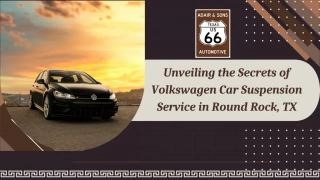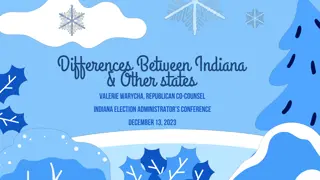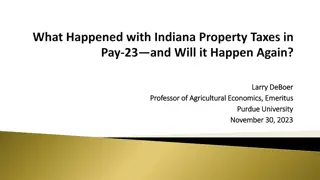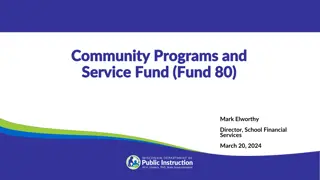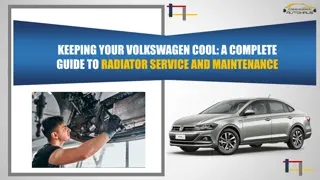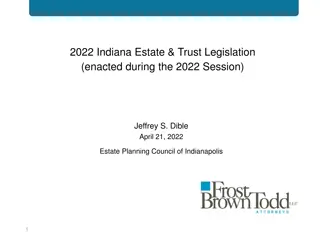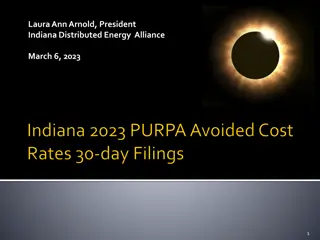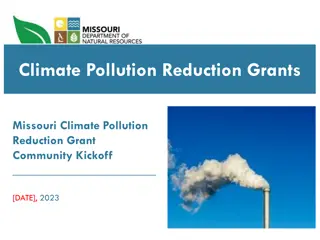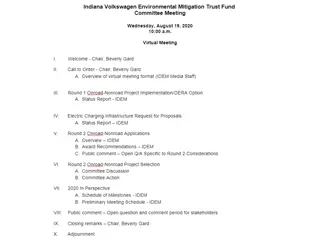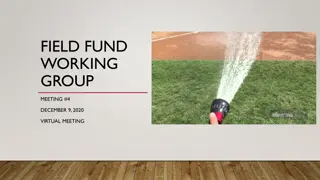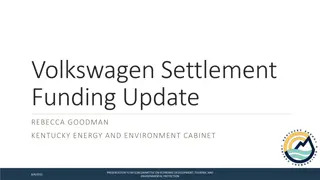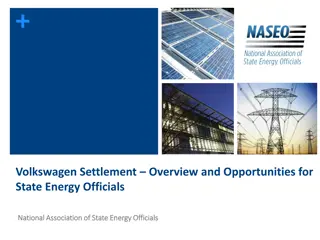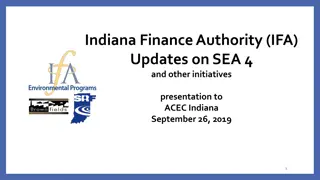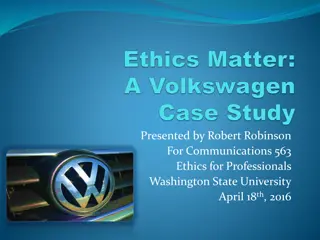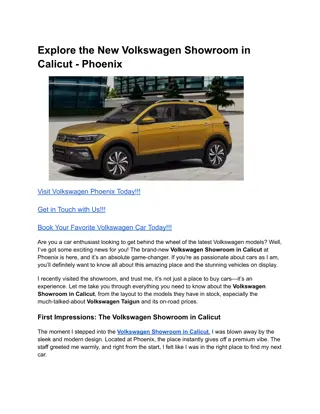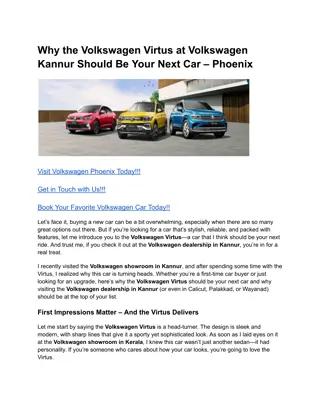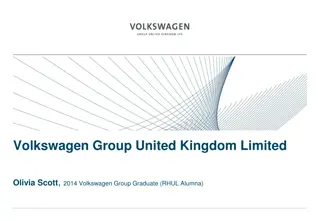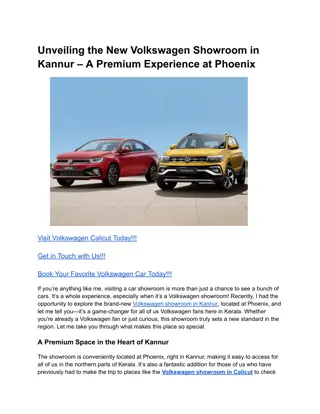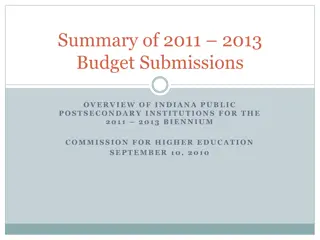Indiana Volkswagen Environmental Trust Fund Committee Meeting Update
The Indiana Volkswagen Environmental Trust Fund Committee Meeting discussed updates on Round 1 projects including electric school buses, non-road equipment projects, and transit bus initiatives. The meeting also covered the DERA Option Applications and Electric Vehicle Charging Infrastructure. Progress on various projects was highlighted, with a focus on cost-effectiveness and emission reductions. Public comments were invited, and the session concluded with remarks from the Chair.
Download Presentation

Please find below an Image/Link to download the presentation.
The content on the website is provided AS IS for your information and personal use only. It may not be sold, licensed, or shared on other websites without obtaining consent from the author. Download presentation by click this link. If you encounter any issues during the download, it is possible that the publisher has removed the file from their server.
E N D
Presentation Transcript
Indiana Volkswagen Environmental Mitigation Trust Fund Committee Meeting I. Welcome - Chair, Beverly Gard II. Call to Order - Chair, Beverly Gard III. Round 1 Onroad-Nonroad Project Implementation A. Status Report - IDEM IV. DERA Option Applications A. Overview of Scoring IDEM B. Project Award Recommendations IDEM C. Committee Discussion and Action - Committee V. Electric Vehicle Charging Infrastructure Request for Proposals A. Overview of Workshop and Stakeholder Input IDEM B. Identification of Goals and Objectives for Infrastructure Investment IDEM -Discussion and Action - Committee C. Outline of Key Decision Points and Considerations IDEM -Discussion and Action - Committee VI. Round 2 Onroad-Nonroad RFP A. Overview of Refinements to RFP and Scoring Criteria IDEM B. Direction on Path Forward - Committee VII. 2020 In Perspective A. Schedule of Milestones - IDEM B. Preliminary Meeting Schedule - IDEM VIII. Public comment - Open floor for stakeholders IX. Closing remarks Chair, Beverly Gard 1 X. Adjournment
Indiana Volkswagen Environmental Mitigation Trust Program Round 1 Update, DERA Option, Electric Vehicle Charging Infrastructure, Round 2 Refinements, and Program Next Steps January 31, 2020 2
Round 1 Onroad-Nonroad Projects Update 3
Round 1 Onroad and Nonroad Project Implementation 34 projects awarded 4 electric school bus projects underway and on schedule 12 nonelectric school bus projects underway and on schedule (4 diesel, 8 propane) 1 propane project reimbursement request from Trustee underway 4 nonroad equipment and vehicle projects underway and on schedule (1 diesel, 3 electric) 1 regional haul project underway and on schedule (CNG) 3 transit bus projects underway (1 CNG, 2 electric) CNG project on schedule Electric projects potentially delayed 7 short haul/drayage projects underway and on schedule (4 diesel, 2 CNG, 1 electric) 1 diesel project reimbursement request from Trustee underway 3 refuse hauler projects underway and on schedule (CNG) Total vehicles funded: 179 Total project costs: $31,012,421 Total Indiana VW award support: $9,830,683 4
Round 1 DERA Option Applications 5
Overview of Scoring 5 applications received 1 switcher locomotive to electric alternative 1 diesel landfill compactor to clean-diesel alternative (2 units) 2 diesel terminal trucks to electric alternatives 1 diesel front end loader to clean-diesel alternative Each application reviewed for eligibility Outstanding questions on one application Each application s cost effectiveness and total NOx emission reductions were calculated using U.S. EPA s Diesel Emission Quantifier Each application scored by 3 technical staff making up the review team using VW Committee-approved criteria 6
Round 1 Application Considerations A total of $1,800,000 was made available for Round 1 of the DERA Option Program A total of $1,311,298 was requested from Round 1 of the DERA Option Program Remaining DERA Option funding should be rolled into DERA Option Round 2 after RFP refinements Although IDEM received only 5 applications in Round 1, all are quality projects with notable emission reduction potential, for example: NOx reductions from 1 diesel-to-diesel compactor would require replacement of 13 diesel-to-propane school buses Diesel-to-diesel compactor is 38% more cost-effective than a diesel-to-propane school bus 7
Round 1 Application Considerations Several reasons have been communicated for why the number of applications was lower than expected Wanted to compare Round 1 Volkswagen and Round 1 DERA Option in relation to technology options and competition before proceeding in future rounds Waiting to see what others in their industries are doing to determine technology options Timing around holidays made contact between vendors, staff, decision-makers, and consultants difficult for approvals to move forward Weather was good and physical port activities were priority over administrative priorities Several interested applicants did not place matching funds into their 2019 budgets; likely have for 2020 8
Round 1 DERA Option Award Recommendations Project County Funding Request Applicant Match Applicant Project Type Diesel to Electric Terminal Truck Hendricks $143,944 55% Steel Dynamics, Inc. Diesel to Electric Terminal Truck Newton $150,242 55% Ruan Transport Corporation Diesel to Clean-Diesel Landfill Compactors (2) Marion $455,000 75% South Side Landfill, Inc. Diesel to Clean-Diesel Front End Loader Frick Services, Inc. Porter $89,612 75% Diesel Switcher Locomotive to Electric Shuttlewagon ArcelorMittal Burns Harbor Porter $472,500 55% TOTAL $1,311,298 9
Electric Vehicle Charging Infrastructure RFP 10
Background and Workshop Indiana s Beneficiary Mitigation Plan (BMP) includes the maximum 15% allotment of our funding to light-duty electric vehicle charging equipment ($6.14 million) This funding can be used for Direct-Current Fast Charger (DCFC) or Level 2 (L2) charging equipment To gather relevant and detailed information on the development of a statewide EV charging network for Indiana, the EV Charging Infrastructure Workshop was held on October 8, 2019 with panelists that included: Electrify America with an update on the current network and future plans EV manufacturers including General Motors, Subaru, and Cummins Insight on EV implementation strategies from South Shore Clean Cities, Ohio EPA, and Argonne National Lab EV charging equipment manufacturers and users including ChargePoint, Greenlots, and the City of Bloomington Infrastructure development insight from NIPSCO, Duke Energy, and Wabash Valley Power Alliance Roughly 75 interested parties attended the EV Charging Infrastructure Workshop 11
Request for Information On December 12, 2019, IDEM posted a Request for Information (RFI) to obtain stakeholder input to help guide the development of the Indiana EV Charging Infrastructure Program and the associated Request for Proposals (RFP) In this RFI, IDEM posed seven key questions for stakeholder consideration and input: 1. Should DCFC or L2 be the higher priority? 2. Should we fund at highest level permitted under Appendix D-2 of the national consent decree, or work to leverage where possible public and private funds? 3. Should EV chargers be installed where the EVs are currently registered or based on maximum distance between charging locations? 4. Should priority be DCFC along interstates and highways or L2 at workplace, shopping, destination, and multi-unit housing locations? 5. How should total funding be split (if at all) between DCFC and L2 (i.e., 60% for DCFC and 40% for L2)? 6. How many rounds of funding should Indiana make available and how might Indiana split those funds (i.e., Round 1: 40% for L2, followed by Round 2: 60% for DCFC)? 7. Several questions intended to gather information from current EV drivers as well as those who are considering a move to an EV 12
Stakeholder Input in Response to Request for Information IDEM received 30 unique comment submissions with the following considerations: Wide support for statewide Direct-Current Fast Charger (DCFC) network Located 50 100 miles apart Reliable and redundant (multiple charging ports and types at each location) Serves greatest number of EV drivers (urban, rural, apartment dwellers) Should focus on statewide network as opposed to where EVs are located Determine DCFC network needed, then allot that amount of funding to it Support for Level 2 (L2) charging Need both for comprehensive program Funding split between DCFC and L2 Ranged from 40% DCFC and 60% L2 to 100% DCFC Rounds of Funding One round for 100% DCFC (majority of DCFC comments supported one round) If one round of funding, provide ample time to applicants to respond to RFP Support also existed for multiple rounds of funding with a possible higher funding amount in later years to allow for technology costs to lower 13
Goals, Objectives, and RFP Development for EV Infrastructure Investment Discussion and Committee Action 14
Goals and Objectives for EV Infrastructure Investment In developing the Indiana EV Charging Infrastructure Program and RFP, Indiana should strive for the following goals and objectives: To develop a statewide EV charging network that provides EV charging locations to the greatest number of citizens To create a diverse statewide network that meets the needs of Indiana citizens using both DCFC and L2 charging equipment To implement a program that is reliable through multiple charging stations at each location To maximize the available funds of $6.14 million (achieve greatest bang for the buck) To maximize leveraging of public and private where possible to obtain the greatest number of charging locations possible 15
Key Decision Points and Considerations for EV Infrastructure Investment Discussion and Committee Action 16
Key Decision Points and Considerations for EV Infrastructure Investment 1.Should EV chargers be installed where the EVs are currently registered or based on maximum distance between charging locations? a. Focusing on areas of EV registrations better supports and could grow current demand, while focusing on distance between creates better statewide network 2.Should priority be DCFC along interstates and highways or L2 at workplace, shopping, destination, and multi-unit housing locations? a. Interstate and highway priority focuses on longer distance travelers, while L2 in these locations prioritizes local EV users 3.How should total funding be split (if at all) between DCFC and L2 (i.e., 60% for DCFC and 40% for L2)? a. Based on current estimates, a $200,000 investment would cover the cost of one (1) DCFC or the cost of twenty (20) L2 chargers 4.How many rounds of funding should Indiana make available and how might Indiana split those funds (i.e., Round 1: 40% for L2, followed by Round 2: 60% for DCFC)? a. One round gets projects underway as quickly as possible, while multiple rounds provide opportunity for costs savings as installation and technology costs decrease over time 17
Round 2 Onroad and Nonroad RFP 18
Overview of Recommended Refinements Indiana has now completed Round 1 funding for both the Volkswagen Onroad and Nonroad as well as the DERA Option programs. IDEM is always looking for ways to improve programs and the following are recommended revisions for Round 2 funding: Remove points for Indiana business and MBE/WBE/VBE applicants and redistribute to transformational potential and leveraging of resources (these points had little impact in scoring or separating projects) Clarify that applications will not be considered if not fully funded and shovel-ready (several current projects are delayed due to contingent funding from 3rd parties) Require 1,000 operating hour requirement for only switcher locomotives and not nonroad and marine equipment (this is consistent with Appendix D-2 and was a limiting factor in both RFPs) When EPA s Diesel Emission Quantifier does not have default values, general business practices or industry averages will be used in emission reduction calculations Only allow diesel-to-diesel projects for certain types of onroad vehicles (diesel-to- diesel projects should focus on most locally impactful vehicles such as school buses and refuse haulers) 19
Overview of Recommended Refinements Discussion and Committee Action 20
2020 Schedule of Milestones Volkswagen Committee Involvement Milestone Estimated Completion February/March 2020 NA Round 2 Onroad and Nonroad RFP posted (60 days) Review and/or Approve May/June 2020 Round 2 Onroad and Nonroad awards announced EV Infrastructure RFP (180 days) March/April 2020 NA Review and/or Approve October/November 2020 EV Infrastructure awards announced September 2020 NA Round 2 DERA Option RFP posted (60 days) Review and/or Approve December 2020 Round 2 DERA Option RFP awards announced 22
2020 Preliminary Meeting Schedule Volkswagen Committee Involvement Related Program Potential Meeting Date March/April 2020 Review and/or Approve EV Infrastructure RFP May/June 2020 Review and/or Approve Round 2 Onroad and Nonroad awards October/November 2020 Review and/or Approve EV Infrastructure awards Round 2 DERA Option awards December 2020 Review and/or Approve 23
Opportunity for Committee to Seek Input or Public Comments from Attendees 24
For More Information Indiana Volkswagen Mitigation Trust Program website: www.idem.IN.gov/vwtrust For program assistance: Shawn Seals Senior Environmental Manager IDEM Office of Air Quality (317) 233-0425 SSeals@idem.IN.gov 25






